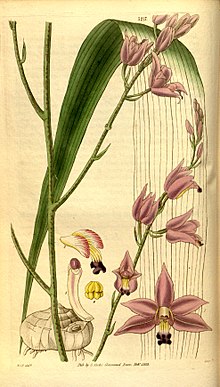Bletia purpurea
| Bletia purpurea | |
|---|---|

| |
| 1833 illustration Curtis's Botanical Magazine | |
| Scientific classification | |
| Kingdom: | Plantae |
| Clade: | Tracheophytes |
| Clade: | Angiosperms |
| Clade: | Monocots |
| Order: | Asparagales |
| Family: | Orchidaceae |
| Subfamily: | Epidendroideae |
| Genus: | Bletia |
| Species: | B. purpurea
|
| Binomial name | |
| Bletia purpurea (Lam.) DC.
| |
| Synonyms[1][2] | |
| |
Bletia purpurea, common name pine-pink or sharp-petaled bletia, is a species of orchid widespread across much of Latin America and the West Indies, and also found in Florida.[3] They are terrestrial in swamps or sometimes found growing on logs or stumps above the high tide mark.[4][5][6][7][8][9][10]
Bletia purpurea can reach a length of 180 cm (5 feet). It has ovoid (egg-shaped) pseudobulbs up to 4 cm (1.6 inches) in diameter. Leaves are linear or narrowly elliptic, up to 100 cm (40 inches) long. Flowers are pink, purple, or occasionally white, in racemes or panicles sometimes with as many as 80 flowers. Sepals are smaller than those of B. patula, usually less than 30 mm (1.2 in) long.[11][12][13][14][15][16]
References[]
- ^ Tropicos
- ^ The Plant List
- ^ Kew World Checklist of Selected Plant Families
- ^ Flora of North America v 26 p 602.
- ^ Dodson, C.H. & P.M. Dodson. 1980. Orchids of Ecuador. Icones Plantarum Tropicarum 1: 1–100.
- ^ CONABIO. 2009. Catálogo taxonómico de especies de México. 1. In Capital Nat. México. CONABIO, Mexico D.F..
- ^ Ames, O. & D. S. Correll. 1953. Orchids of Guatemala. Fieldiana, Bot. 26(2): 399–727.
- ^ Carnevali F., G., J. L. Tapia-Muñoz, R. Jiménez-Machorro, L. Sánchez-Saldaña, L. Ibarra-González, I. M. Ramírez & M. P. Gómez. 2001. Notes on the flora of the Yucatan Peninsula II: a synopsis of the orchid flora of the Mexican Yucatan Peninsula and a tentative checklist of the Orchidaceae of the Yucatan Peninsula biotic province. Harvard Papers in Botany 5(2): 383–466.
- ^ Funk, V. A., P. E. Berry, S. Alexander, T. H. Hollowell & C. L. Kelloff. 2007. Checklist of the Plants of the Guiana Shield (Venezuela: Amazonas, Bolivar, Delta Amacuro; Guyana, Surinam, French Guiana). Contributions from the United States National Herbarium 55: 1–584.
- ^ Amazilia, pine-pink
- ^ Candolle, Augustin Pyramus de. Mémoires de la Société de Physique et d'Histoire Naturelle de Genève 9(1): 97–98. 1841.
- ^ Lamarck, Jean Baptiste Antoine Pierre de Monnet de. Encyclopédie Méthodique, Botanique 3(2): 515. 1791.
- ^ Dodson, C. H. and P. M. Dodson. 1980. Bletia purpurea. Icones Plantarum Tropicarum 1: plate 7.
- ^ McLeish, I., N. R. Pearce & B. R. Adams. 1995. Native Orchids of Belize. 1–278.
- ^ Godfrey, R. K. & J. W. Wooten. 1979. Aquatic and Wetland Plants of Southeastern United States Monocotyledons 1–712. The University of Georgia Press, Athens.
- ^ Wunderlin, R. P. 1998. Guide to the Vascular Plants of Florida i–x, 1–806. University Press of Florida, Gainesville.
Categories:
- Bletia
- Orchids of Florida
- Orchids of Belize
- Orchids of Mexico
- Orchids of Central America
- Flora of the Caribbean
